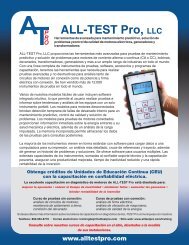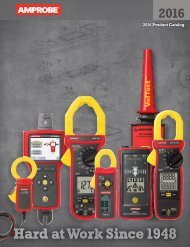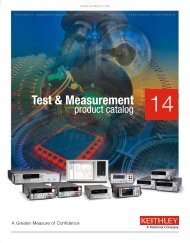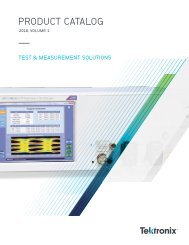Catalogo Raytek 2013
CEDE instrumentos de medición, distribuidor autorizado Raytek para todo México. Catalogo de termómetros IR 2013.
CEDE instrumentos de medición, distribuidor autorizado Raytek para todo México. Catalogo de termómetros IR 2013.
You also want an ePaper? Increase the reach of your titles
YUMPU automatically turns print PDFs into web optimized ePapers that Google loves.
Things to<br />
consider when<br />
selecting a<br />
sensor<br />
■ What is the temperature<br />
range of the target?<br />
■ What is the size of<br />
the target?<br />
■ How close to the target<br />
can the instrument be<br />
installed?<br />
■ Does the target fill the<br />
field of view?<br />
■ What is the target<br />
material?<br />
■ How fast is the target<br />
or process moving?<br />
■ Will you be measuring<br />
discrete objects or a<br />
continuous process?<br />
■ What is the ambient<br />
operating temperature?<br />
■ Are the ambient<br />
conditions<br />
contaminated<br />
(dust, smoke, steam)?<br />
■ Do you want to<br />
connect to existing<br />
control equipment?<br />
■ Do you need to keep<br />
records for audit or<br />
quality programs?<br />
How Infrared Temperature Sensors Work<br />
Infrared radiation is just one part of the electromagnetic spectrum that also includes radio waves,<br />
microwaves, visible light, and ultraviolet light, as well as gamma rays and X-rays. The infrared range of<br />
the electromagnetic spectrum falls between the visible portion of the spectrum and radio waves. Infrared<br />
wavelengths are usually expressed in microns (10 -6 m or µm), with the infrared spectrum extending from<br />
0.7 microns to 1000 microns. Only the 0.7 to 18 micron band is used for infrared temperature measurement.<br />
As shown in the figure to the left, an object<br />
reflects, transmits, and emits energy. The intensity<br />
of an object’s emitted infrared energy increases<br />
or decreases in proportion to its temperature.<br />
Emissivity is a term used to quantify the energyemitting<br />
characteristics of different materials<br />
and surfaces.<br />
Most <strong>Raytek</strong> infrared sensors have adjustable<br />
emissivity settings, usually from 0.1 to 1.0, which<br />
allow accurate temperature measurements of<br />
various surface types.<br />
An infrared sensor detects the energy emitted<br />
from an object and focuses that energy onto one<br />
or more detectors. The detector converts the<br />
infrared energy to an electrical signal, which is in<br />
turn converted into a temperature value based<br />
on the sensor’s calibration equation and the<br />
emissivity setting. This temperature value can be<br />
displayed on the sensor, output as an analog signal, or — in the case of a smart sensor — converted to a<br />
digital output and displayed on a computer terminal.<br />
More Than Specifications:<br />
Selecting The Right Infrared Temperature Sensor For Your Application<br />
What is the temperature range of your process? How big is the measurement spot? How far away is that<br />
spot from the sensor? These are the first questions<br />
to ask to identify the right <strong>Raytek</strong> temperature<br />
sensor for your application. Environmental and<br />
operating conditions will determine other sensor<br />
specifications (e.g., ambient temperature, display<br />
and output, and protective accessories).<br />
<strong>Raytek</strong> offers a variety of products with specific<br />
temperature measurement features. Single<br />
wavelength infrared temperature sensors need a<br />
clear line of sight between the instrument and<br />
the target. Sighting optics allow the user to aim<br />
the sensor on the target. Some instruments have<br />
a built-in laser that pinpoints the target, which is<br />
especially helpful with small targets or in dark or<br />
inaccessible areas.<br />
A two-color or double wavelength instrument is<br />
most effective when the target is very small,<br />
partially obstructed or is moving in and out of the<br />
Optical charts help determine the spot<br />
size at a specific distance. The smallest<br />
spot this instrument can measure is 0.25<br />
inches at a distance of 8 inches.<br />
In variable focus instruments,<br />
the spot size can be adjusted.<br />
field of view. A fiber-optic unit, where the cable can snake around obstructions, is best if a direct line of sight<br />
between the instrument and the target is otherwise impossible.<br />
Target Size and Material<br />
For single wavelength sensors, the measurement target should be larger than the field of view by 50%.<br />
If the target is smaller than the field of view, background objects (for example, a furnace wall) will influence<br />
the temperature reading. The target material’s temperature range, emissivity, and surface characteristics<br />
4

















